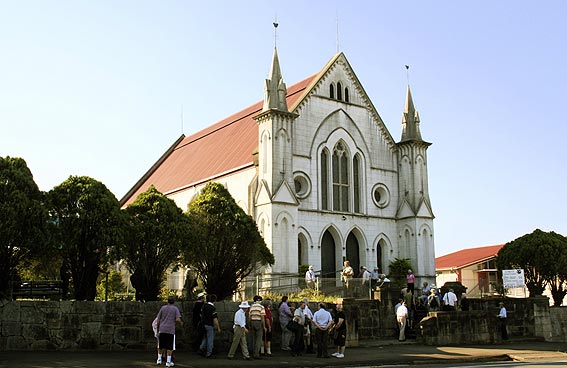
Surface Hill Uniting (formerly Methodist) Church
[Photograph by Trevor Bunning (October 2007)]

Surface Hill Uniting (formerly Methodist) Church
[Photograph by Trevor Bunning (October 2007)]
Historical and Technical Documentation by Geoffrey Cox
© OHTA 1989, 2007, 2011 (last updated March 2011)
The foundation stone of the present Surface Hill Uniting Church was laid on 30 January 1890. The building was constructed to the design of the Swedish-born Gympie architect, Hugo Wilhelm Durietz (1831-1908), and was officially opened on 7 August 1890. This was the third church building on this site at the crest of Surface Hill: The first was a bark hut erected by the Wesleyan Methodists in 1868 soon after the discovery of gold in the area, and the second a timber building built in 1869 to the design of local architect Charles G. Smith. The latter was re-located to the north-east corner of the site facing Barter Street, where it has served as a hall and to accommodate the parish office.1
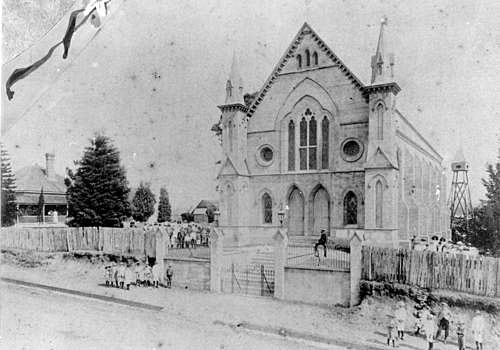
Surface Hill Methodist Church, c.1900
[Photograph: John Oxley Library, State Library of Queensland]
The nameplate on the organ records that it was built by George Benson of Manchester. This is one of only two organs supplied by Benson for Australia, the other being the instrument he built in 1889 for the Wesleyan Church, Albert Street, Brisbane.
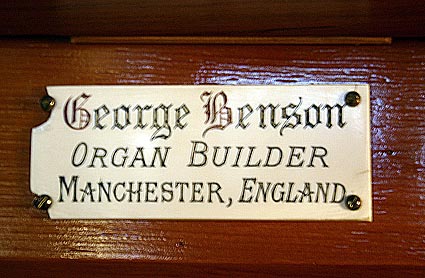
The builder's nameplate on the organ
[Photograph by Trevor Bunning (October 2007)]
At the time of its completion in June 1888, a recital was given on the instrument by Mr A.E. Jones at Benson's organ works in Manchester. It was described at the time as having been built for "Mr James Lord, of Brisbane, Queensland, Australia".2 The organ was presumably intended for Lord's residence in Brisbane, and the circumstances under which it came to be installed in the Gympie church can be pieced together from anecdotal and other evidence.
A biographical account of Lord, dating from 1888, shows that he had a long association with the Albert Street Wesleyan Church in Brisbane:
JAMES LORD, J.P., Accountant in Insolvency, was born in 1840 in the town of Burnley, in Lancashire, England, . . . Arrived in Brisbane in 1875, he became engaged as chief accountant in the office of Messrs. Scott, Dawson, and Stewart, merchants . . . and was finally admitted a partner of the firm. From this he retired in 1883, and paid a visit to his native country, whence he returned in 1884 . . . organist and conductor of the Albert-street Wesleyan Church choir and honorary organist of the Brisbane Musical Union.3
His departure in July 1883 was marked by special recognition of his services as organist at the Albert Street church:
Presentation to an organist - The duties of organist of the Albert-street Wesleyan Church have been performed for several years past by Mr James Lord, J.P., in a manner most efficient and generous, and without fee or reward. Within a few days he and his family will leave for England, with a probable view of remaining there. ... He first took charge of an organ and choir in 1859 - in Manchester.4
Lord appears to have returned to Brisbane in 1884, however, and was described again as organist of the Albert Street Wesleyan Church in 1889 when the new church was opened, along with a three-manual organ by George Benson of Manchester, built to Lord's specification.5 Lord remained active as the organist at Albert Street in 1891,6 but was replaced as organist there in May 1892 by Mr S.G. Benson.7 His long term as organist was recognised in an address presented to him at the church anniversary services in November that year.8 Economic retrenchment was later reported to have necessitated his moving to Western Australia, where he died in 1904.9
At the time of Lord's death, it was reported that he had lost his first wife in the wreck of the 'Quetta' off the coast of North Queensland in 1890, and that he later married a Brisbane lady.10 'Quetta' had left Brisbane on 18 February 1890, and struck rock off Cape York. It sank almost immediately with a loss of 133 lives out of the total 293 on board.11 Among those who died were Lord's wife and young son.12 It is reported that he found the organ too painful a reminder of them and sold it for £250 to the Gympie church. Lord himself is said to have played at the opening recital on the organ in Gympie.13
In a varied (and less plausible) version of the story, Lord and his wife are described as being on board a ship carrying the organ to Australia, but the same reason for disposing of the instrument is given:
Not long before the turn of the century, an organ built by "Benson, London" according to an affixed plate, lay securely crated in the hold of a ship outward-bound for Australia. It was the pride and joy of two of the passengers, a young man and his bride, who saw in it a source of solace and delight in their spare time in a new and possibly difficult country. But fate took its hand, and even before their treasure had been re-assembled in their new homeland, the young wife had died. Despairing of ever being able to bear to play the organ again, the young man sold it to a church in Gympie.14
Whatever the details, it is clear that Lord's nine-stop organ for Brisbane found its way to Gympie shortly after the 'Quetta' disaster in 1890. An inscription in the Great windchest of the organ (discovered by Simon Pierce during restoration in 1997) confirms that the instrument has been in the church from the time it was opened:
This organ was erected in Wesleyan Church Gympie by B B Whitehouse of Brisbane July 1890.15
B.B. Whitehouse was employed at this time by W.H. Paling & Co. Limited in Brisbane as head tuner,16 and it was presumably in this capacity that he installed the organ.
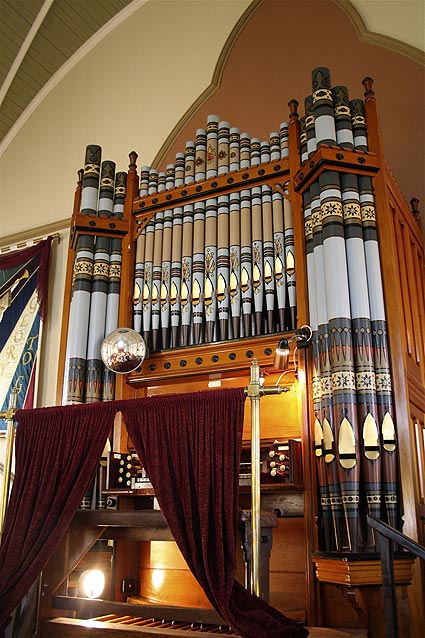
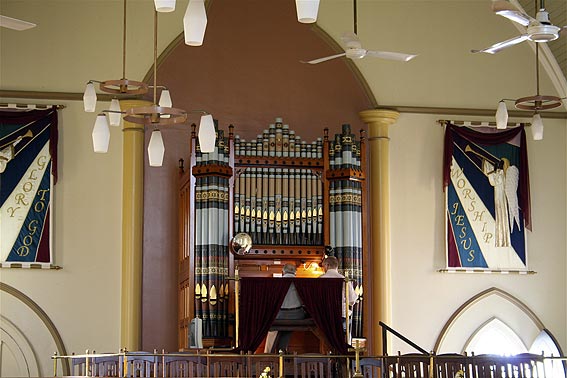
[Photographs by Trevor Bunning (October 2007)]
Despite having apparently been designed as a residence organ, this instrument sounds very complete in the building, and it is remarkable in that it has survived without substantial alteration. It was reconditioned by Whitehouse Bros in 1979,17 and a new blower was supplied by David Hudd around 1986. Restoration of the stencilling of the façade pipes was carried out by members of the congregation during the 1980s.
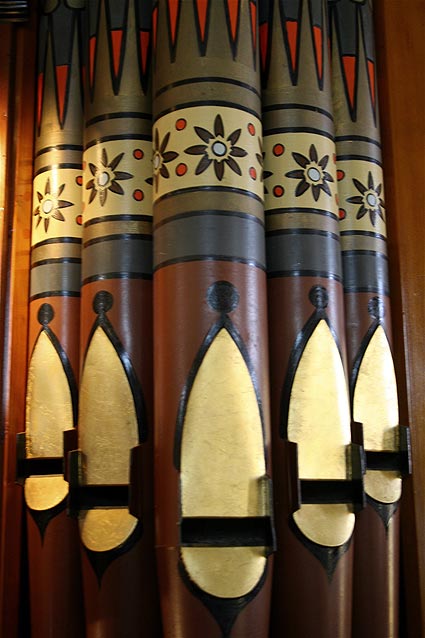
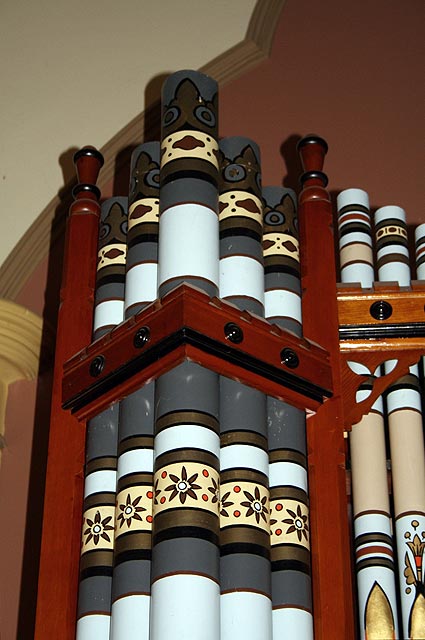
Stencilling on the façade pipes restored in the 1980s
[Photographs by Trevor Bunning (October 2007)]
The organ was originally handblown, and the feeders and blowing handle remain intact. A hydraulic pump, used at a later stage, has also been restored but is no longer connected to the organ.
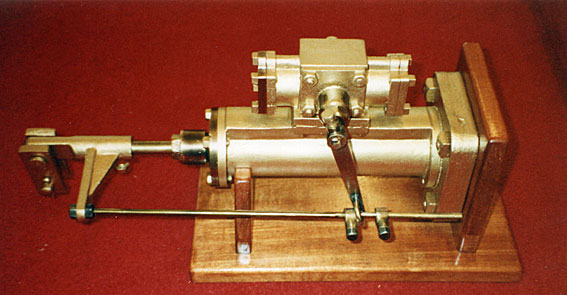
The restored hydraulic pump, no longer in use
[Photograph by Howard Baker (October 1989)]
The most recent restoration of the instrument by W.J. Simon Pierce of Brisbane was carried out in stages: The soundboards and pipework were restored in 1997, while the action, case and pedal chests were restored in 1998. Until 1997 the pipework was cone-tuned, but tuning slides were fitted at this time (without trimming the tops of the pipes) in order to arrest further damage. The double-rise bellows have been retained. There is a common soundboard for the two manuals, as was later used by Whitehouse at Wesley Church, Kangaroo Point and elsewhere. The balanced swell pedal (with vertical swell shutters) is reported to be original.18
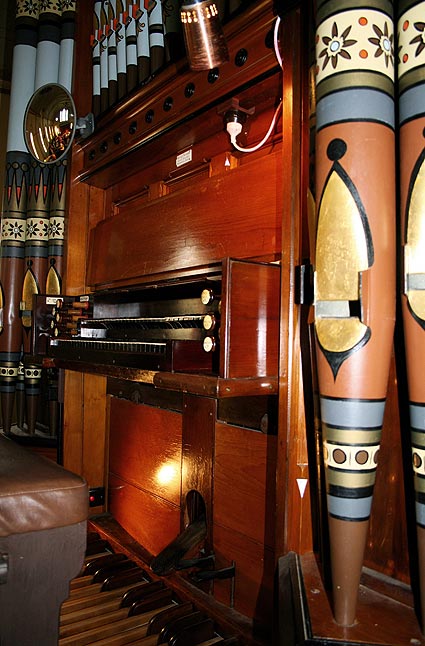
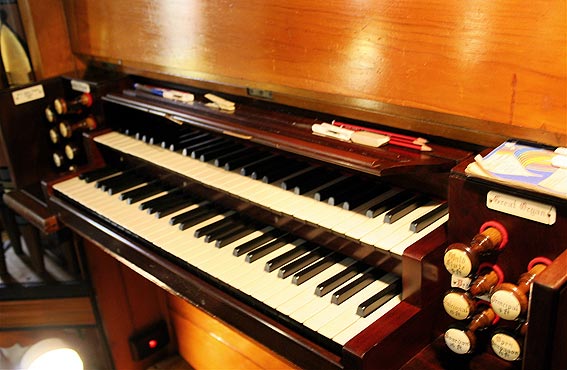
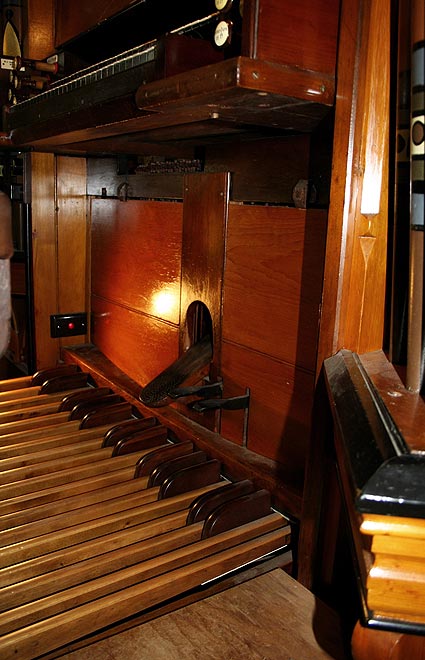
The console of the Benson organ
[Photographs by Trevor Bunning (October 2007)]
| GREAT Open Diapason Salcional [sic.] Principal Wald Flute SWELL Open Diapason Lieblich Gedact Gemshorn Oboe PEDAL Bourdon COUPLERS Swell to Great Great to Pedals Swell to Pedals |
8 8 4 4 8 8 4 8 16 |
[stopped bass] [open wood] [gvd bass] [stopped, metal] [Ten.C] |
Drawstop console (box lid)
Balanced swell pedal (original)
2 combination pedals to Great Organ
Compass: 56/30
Pedalboard: concave and straight
Originally handblown
Mechanical action.19
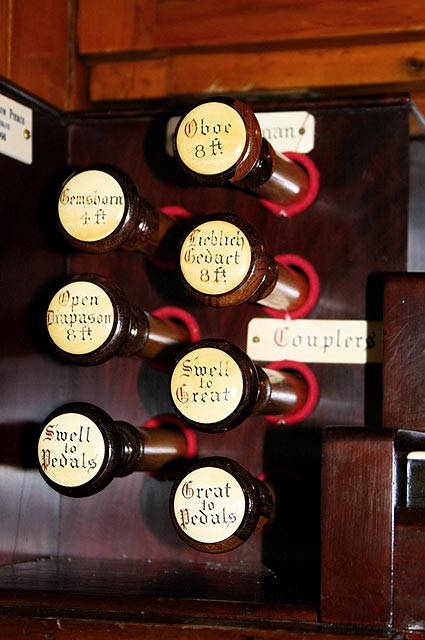
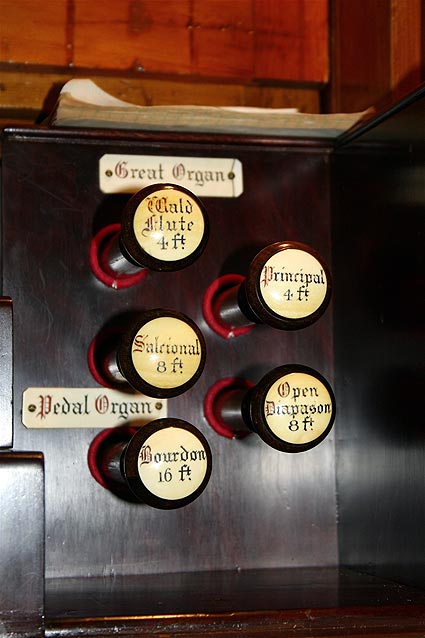
The stop jambs on the organ console
[Photographs by Trevor Bunning (October 2007)]
___________________________________________________________________
1 Queensland Heritage Council, Queensland Heritage Register, location 601529; Donald Watson & Judith McKay, Queensland Architects of the 19th Century: A Biographical Dictionary (Brisbane: Queensland Museum, 1994), pp. 57-59; R. S. C. Dingle, Annals of Achievement: A Review of Queensland Methodism, 1847-1947 (Brisbane: Queensland Book Depot, 1947), p. 261;
2 Musical Opinion & Music Trade Review, vol. 11, no. 130 (1 July 1888), p. 454.
3 W. Frederic Morrison, The Aldine History of Queensland (Sydney: Aldine, 1888), II, Appendix, p. 220.
4 The Brisbane Courier (13 July 1883), p. 5.
5 The Daily Mail (Brisbane, 10 March 1906), p. 9.
6 The Brisbane Courier (29 September 1891), p. 4.
7 The Brisbane Courier (9 May 1892), p. 4; The Brisbane Courier (28 May 1892), p. 5.
8 The Brisbane Courier (16 November 1892), p. 5.
9 The Methodist Recorder (26 November 1904).
10 The Methodist Recorder (26 November 1904).
11 John Bayton, Cross over Carpentaria: being a History of the Church of England in Northern Australia from 1865-1965 (Brisbane: W. R. Smith & Paterson, 1965), pp. 64-65.
12 The Brisbane Courier (3 March 1890), p. 5; The Brisbane Courier (10 March 1890), p. 5.
13 W.J. Simon Pierce, 'Restorations: Surface Hill Uniting Church, Gympie, Qld,' OHTA News, vol. 22, no. 2 (April 1998), pp. 9-11. This is an amplified version of an article that appeared in The Organ Voice, vol. 23, no. 4 (December 1997), pp. 14-16.
14 Frederic Rogers, 'The organ has a voice unique in music,' The Sunday Mail Magazine (18 June 1967), p. 2.
15 W.J. Simon Pierce, op.cit.
16 Geoffrey Cox, 'B.B. Whitehouse and the First Organ Built in Queensland,' OHTA News, vol. 35, no. 1 (January 2011), p. 23.
17 The Courier Mail (22 December 1979).
18 W.J. Simon Pierce, op.cit. See also: The Organ Voice, vol. 24, no. 1 (March 1998), back cover & 'News from Organ Builders,' The Organ Voice, vol. 24, no. 2 (June 1998), p. 28.
19 Specification noted by G. Cox, 1974 & 1989.
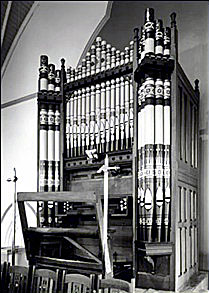
[Photograph by Richard Stringer, published in
Organ Society of Queensland Newsletter, vol. 18, no. 5 (April 1991), p. 7]
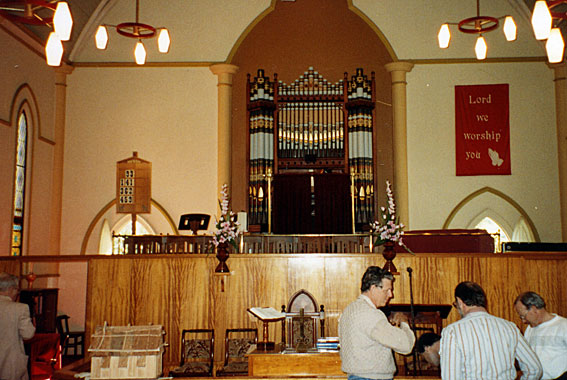
[Photograph by Howard Baker (October 1989)]
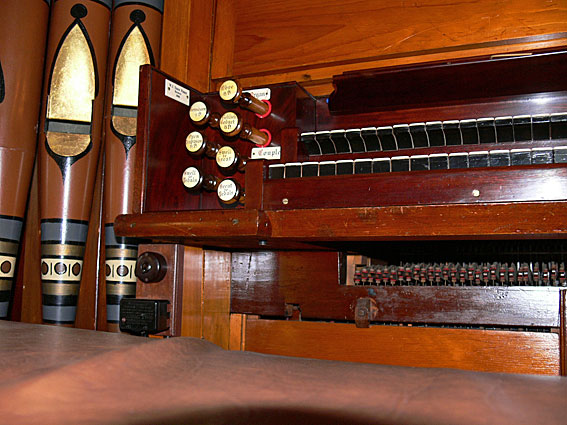
[Photograph by John Maidment (October 2007)]
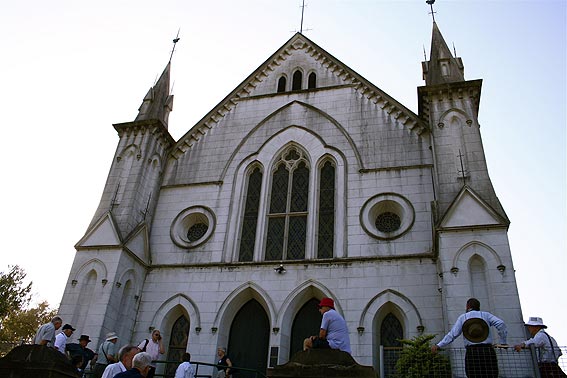
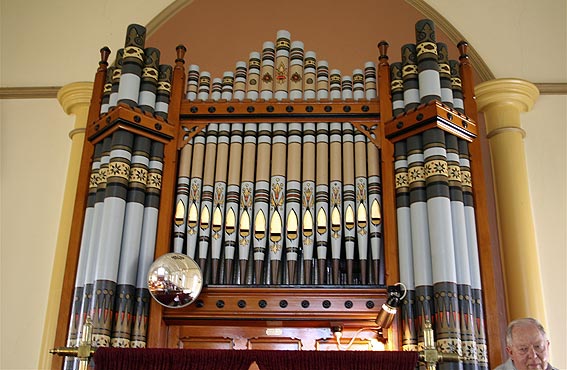
 [
[
Photographs by Trevor Bunning (October 2007)]